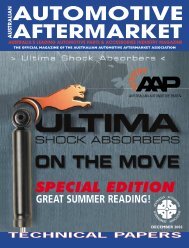AM MAGAZINE SHELL - Australian Automotive Aftermarket Magazine
AM MAGAZINE SHELL - Australian Automotive Aftermarket Magazine
AM MAGAZINE SHELL - Australian Automotive Aftermarket Magazine
Create successful ePaper yourself
Turn your PDF publications into a flip-book with our unique Google optimized e-Paper software.
HR<br />
TAX ON LEAVE ENTITLEMENTS<br />
UPON TERMINATION<br />
Employers are often confused about how to tax leave entitlements, such as annual<br />
leave and long service leave on termination. This article clarifies how to tax such<br />
entitlements.<br />
David Wilkinson<br />
AAAA Industrial, Relations Manager<br />
Phone 1300 735 306 Fax 02 9993 9709<br />
Email hr@aaaa.com.au<br />
CALCULATION METHOD<br />
• Calculate the gross amount of leave<br />
entitlements owing to the employee<br />
• Divide the gross amount owing by 52<br />
• Add the amount to the normal weekly<br />
amount<br />
• Find tax on the new amount<br />
• Find tax on regular weekly amount<br />
• Find difference in tax amount<br />
• Multiply difference by 52: this is the<br />
amount of tax<br />
CASE STUDY:<br />
Employee earns gross per week - $700<br />
(hourly is $18.42)<br />
Tax (with leave loading) - $99<br />
Net payment weekly - $601<br />
On termination, the employee has<br />
121.69 hours worth of annual leave.<br />
For this particular employee, leave<br />
loading is not be payable upon<br />
termination.<br />
121.69 x $18.42 = 2241.53<br />
$2241.53 / 52 = 43.11<br />
$43.11 + $700 = 743.11<br />
New weekly tax rate on $743.11 = 113<br />
$113 - $99 = $14<br />
$14 x 52 = $728<br />
Therefore<br />
Gross termination payment = $2241.53<br />
Tax on termination payment = $728<br />
Net termination payment =$1513.78<br />
TAX ON REDUNDANCY PAYMENTS<br />
Genuine Redundancy Payments are tax<br />
free up to a limit ($7350 plus $3676 for<br />
each completed year of service to which<br />
the payment relates - for 2008/2009,<br />
indexed annually).<br />
A genuine redundancy payment is one<br />
“received by an employee who is<br />
dismissed from employment because the<br />
employee’s position is genuinely<br />
redundant”. There are four necessary<br />
components to a genuine redundancy.<br />
These include:<br />
1. The payment being tested must be<br />
received in consequence of an<br />
employee’s termination.<br />
2. The termination must involve the<br />
employee being dismissed from<br />
employment.<br />
3. The dismissal must be caused by the<br />
redundancy of the employee’s position.<br />
4. The redundancy payment must be<br />
made genuinely because of a<br />
redundancy.<br />
The dismissal must be<br />
caused by the redundancy<br />
of the employee’s position<br />
The genuine redundancy payment is<br />
the amount that exceeds the amount that<br />
could reasonably be expected to be<br />
received had the employee voluntarily<br />
terminated his or her employment (for<br />
example, if the employee resigned, and<br />
would be entitled to $3000, this would<br />
not be included in the calculation of the<br />
tax free amount).<br />
OTHER CONDITIONS THAT<br />
MUST BE SATISFIED<br />
• the employee must be less than 65 at<br />
the date of dismissal (or a lower age if<br />
their retirement is to be at a lower age)<br />
• the termination is not at the end of a<br />
fixed period of employment<br />
• if the employer and employee are not<br />
dealing with each other at arm’s length<br />
(e.g. they are related to each other), the<br />
payment is not greater than the amount<br />
that could reasonably be expected to<br />
have been paid if they had been<br />
dealing with each other at arm’s length<br />
• there is no arrangement between the<br />
employer and employee for the<br />
dismissed employee to be re-employed<br />
after the termination — this condition<br />
would not prevent the former employee<br />
being engaged as an independent<br />
contractor<br />
• The payment is not in lieu of<br />
superannuation benefits.<br />
CASE STUDY<br />
John’s position becomes redundant<br />
when the customer service division of his<br />
employer is outsourced. John is aged 51<br />
and has worked for his employer for 18<br />
years and five months. The $90,000<br />
redundancy payment that he is paid on<br />
May 1, 2009 satisfies the conditions set<br />
out.<br />
The redundancy payment is taxed as<br />
follows.<br />
1. No part of the $90,000 is taxed under<br />
other rules. Although John may receive<br />
a payment for unused leave or in lieu<br />
of notice, for example, as long as this is<br />
a separate payment it is taxed under its<br />
own rules and does not need to be<br />
separated from the redundancy<br />
payment.<br />
2. The tax free amount of the redundancy<br />
payment is:<br />
$7350 + $66,168 ($3676 x 18 years)<br />
= $73,518<br />
The $16,482 in excess of the tax free<br />
amount ($90,000 – $73,518) is taxed as<br />
an employment termination payment.<br />
Because John is aged 51 at the time of<br />
payment, the $73,518 is included in his<br />
assessable income and taxed at his<br />
ordinary tax rates but with a maximum rate<br />
of 31.5 percent.<br />
DO YOU HAVE A QUESTION YOU REALLY WANT TO ASK?<br />
For more information and assistance phone: AAAA HR Hotline on 1300 735 306 or email hr@aaaa.com.au<br />
The material contained in this publication is general comment and is not intended as advice on any particular matter. No reader should act or fail to act on the basis of any<br />
material contained herein. The material contained in this publication should not be relied on as a substitute for legal or professional advice on any particular matter. Wentworth<br />
Human Resources Pty Limited (the publishers), the editor and the authors expressly disclaim all and any liability to any persons whatsoever in respect of anything done or omitted<br />
to be done by any such person in reliance whether in whole or in part upon any of the contents of this publication. Without limiting the generality of this disclaimer, no author or<br />
editor shall have any responsibility for any other author or editor. © Wentworth Human Resources Pty Ltd 2009<br />
Before acting on any of the information in the above article,<br />
please contact David or any of the friendly team at the AAAA<br />
HR Advisory Service on phone: 1300 735 306, fax: 02 9993<br />
9709, or email: hr@aaaa.com.au The AAAA HR Advisory<br />
Service is available from 8:30 am – 5:00 pm, Monday to<br />
Friday. The answer could be just a phone call away!<br />
AU T O M O T I V E A F T E R M A R K E T M AG A Z I N E D E C E M B E R 2 0 0 9 61

















